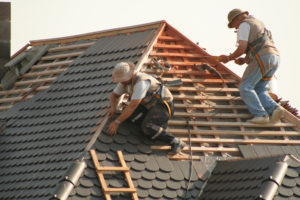Shane Smith | Property Insurance Coverage Law Blog | August 31, 2016
The Utah Court of Appeals ruled last week that a homeowners’ insurance policy did not cover water damage where the house did not have a “complete” roof.1
In this case, the Poulsens were in the process of replacing roof shingles on their house when a storm containing “gusting winds and torrential rains” ripped off the underlayment, allowing rain to enter the interior of the home damaging the structure and their personal property. When they began replacing the shingles they had removed the old shingles and an underlayment of black felt tar paper, exposing the plywood deck. They next installed a new ice and water shield and underlayment. It was when they were installing the last two rolls of underlayment that the storm ripped the underlayment off of the roof.
when a storm containing “gusting winds and torrential rains” ripped off the underlayment, allowing rain to enter the interior of the home damaging the structure and their personal property. When they began replacing the shingles they had removed the old shingles and an underlayment of black felt tar paper, exposing the plywood deck. They next installed a new ice and water shield and underlayment. It was when they were installing the last two rolls of underlayment that the storm ripped the underlayment off of the roof.
Their insurance policy provided limited water coverage,2 however it contained the following Temporary Roof Exception:
The foregoing specified causes of loss are subject to the terms and limitations set forth in Section I …, for any such specified cause of loss or extension of coverage. A roof or wall does not include a temporary roof or wall structure or any kind of temporary tarp, sheeting or other covering.
(Emphasis added.)
When Farmers denied the Poulsens’ claim, they filed suit. Farmers filed a motion for summary judgment on the basis that the Temporary Roof Exception applied because the plywood, IWS, and underlayment layers amounted to only a temporary roof. The court looked at two issues: (1) whether there was a roof; and (2) whether the roof was temporary.
The Poulsens, in opposition to the motion for summary judgment, submitted an expert witness affidavit where their expert opined that because the underlayment and ice and water shield were intended to be permanently installed on the house, the covering was not a temporary roof or other covering. The expert also stated “underlayment without shingles is not a complete roofing system, neither are shingles without … underlayment a complete roofing system per code. It takes both components to make the roofing system resistant to high wind, snow, ice and water.”
However, the court noted that on appeal the Poulsens did not identify “any authority suggesting that component parts of a roof that together fall short of a complete roofing system could fairly be considered a ‘roof’ for purposes of a homeowner’s insurance policy” or “any authority to the effect that an insured ‘could reasonably believe the commonly understood meaning’ of the word ‘roof’ in an insurance policy encompassed an incomplete roof that was unable to resist wind, snow, ice and water.”3
The appellate court held that the trial court did not err by concluding the layers of plywood, ice and water shield, and underlayment did not constitute a roof within the meaning of the insurance policy. Because there was no roof, the policy did not cover damage caused by water entering the Poulsens’ property:
It is true that the court stated that the plywood, IWS, and underlayment “constitute[d] only ‘other coverings’ until such time as shingles are installed.” But the court did not rule these layers made up a temporary roof that the Temporary–Roof Exception would exclude from the LWC Provision’s coverage. Rather, the court ruled that no roof, temporary or permanent, existed at the time of the windstorm, and thus that the LWC Provision did not come into play at all.
1 Poulsen v. Farmers Ins. Exchange, 2016 UT App 170, — P.3d —, 2016 WL 4151905, (Aug. 4, 2016).
2 “We provide limited coverage for direct physical loss or damage to covered property from direct contact with water, but only if the water results from:
(1) the build-up of ice on portions of the roof or roof gutters on a building structure;
(2) hail, rain, snow, or sleet entering through an opening in the roof or wall of a building structure only if the opening is first caused by damage from the direct force of the following:
i. fire;
ii. lightning;
iii. explosion (other than nuclear explosion);
iv. riot or civil commotion;
v. aircraft or vehicles;
vi. vandalism or malicious mischief;
vii. collapse of a building structure or structural part of the building structure;
viii. falling objects; or
ix. windstorm.”
3 See ¶13, footnote 4: Cf. Gutkowski v. Oklahoma Farmers Union Mut. Ins. Co., 2008 OK CIV APP 8, ¶¶ 10–11, 176 P.3d 1232 (holding that “a roof is a unified product comprised of all its component parts and materials, including felt [underlayment], flashing, sheathing (decking), valleys, nails, caulk, drip edges, and shingles” and therefore rejecting an insurance company’s argument that, because asphalt shingles were a second and separate roof from the layers beneath them, it was only obligated to pay for hail damage to the “upper roof” made of asphalt shingles); Dewsnup v. Farmers Ins. Co. of Or., 349 Or. 33, 239 P.3d 493, 499 (2010) (stating that “a roof should be sufficiently durable to meet its intended purpose: to cover and protect a building against weather-related risks that reasonably may be anticipated” and that “the meaning of the term ‘roof’ is sufficiently plain that we need go no further to define its meaning”).
